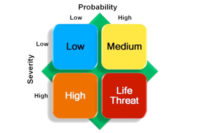The best safety cultures also use altruistic teamwork to achieve world-class results through programs like Behavior-Based Safety (BBS). However, like the army ants, even the best BBS processes can lose momentum and get stuck in a death spiral I call the “venomous cycle.”
Falling into the venomous cycle
Even the most successful BBS processes are not immune to organizational inertia and often lose their initial participation. One of the most common reasons is the lack of perceived value. Employees are usually quick to observe, provide feedback and track their results. But when the observation intelligence gained from the process is not used, misused or just plain ignored, a far too typical scenario follows.
Employees soon lose faith in the process when the data fails to be acted upon. As a result, the next observations completed may not be done with the same quality and the data suffers. If this continues, the employees begin to see no value in doing the paperwork and often will “pencil-whip” the observation by checking off boxes. The BBS team and leaders begin not trusting the data and are more likely to disregard it. And this venomous cycle continues.
Creating a virtuous cycle
Escaping the venomous cycle requires thinking differently about your process data and (re)engaging your leadership team. This requires BBS teams to assess how well they are using their observation intelligence. Strategically using the observation data can help drive the critical importance of the process to the whole organization. Here are some ideas for how to create a virtuous cycle:
• Percent of engaged observers
Many BBS processes track participation by looking at what percent of available observers are turning in observations. But the best BBS processes have employees who are not simply participating, but are truly engaged. BBS teams need to first determine “observer quality metrics” which are characteristics of great observations. Such metrics might include the severity of the risky things observed, percent of at-risk observations with comments, and/or percent of safe observations with comments. Once created, set criteria for a quality observation and then look at the percent of engaged participants. Tracking engaged observers allows your BBS team to identify areas of resistance, identify the cultural barrier and remove it.
• Closure rate of identified issues
A common misinterpretation of BBS is that it blames the worker. When in fact, behavioral observations help identify systems, processes and environmental conditions that are and are not putting employees in a place to perform risky behaviors. Thus, if an employee identifies a work condition that increases the probability of a risky behavior and it cannot be fixed on the spot, then an “open issue” should be created and tracked to closure. This average “time to closure” is a great example of a leading indicator of a strong safety culture. The quicker we can demonstrate that the BBS observations are making a difference to our working conditions, the greater the chance people will see value in performing quality observations. Without this demonstration of value, employees may never see the true benefits of their observations and the problem-solving aspect that is part of the coaching feedback.
• Move away from percent safe
Many BBS processes begin their journey to success by focusing on percent safe observations. This is a valuable first step. But once you get above 90% safe, it is time to change it up! Predictive analytic research has shown that if you have a high number of 100% safe observations, then your incident rate will increase. If your process is producing a high percentage of 100% safe observations, this may indicate a venomous cycle has begun already and it is probably time to change your checklist.
• Use severity when tracking at-risk behaviors
When a risky behavior is observed, we want as much “color” from the observation as we can get. In addition to descriptive comments, BBS processes should use a simple severity metric to categorize their risky behaviors. A simple “low, medium, high” and “life threat severity” category can help differentiate no safety glasses using a computer terminal from no safety glasses while grinding.
Here is a simple exercise to help calibrate your severity matrix. During your next BBS team meeting, hang four sheets of flip chart paper on the wall representing low, medium, high and life threat (or life saved) risky behaviors. Break your team into four groups and have them list risky behaviors based on the designated severity. Have the groups rotate flip charts, and when you are finished, you will have your severity calibrated and can use these lists for future training.
• Get leaders involved
One way to help escape the venomous cycle is to get your leaders engaged and increase their face time with employees. Suggest your leaders walk the jobsite or work floor and ask four simple engagement questions: 1) What are you working on today? 2) What’s the worst thing that could happen? 3) How do you prevent that? 4) What can I do to help? Just by throwing out the right questions, you can’t help but get safety conversations started.
Another suggestion is to have leaders pay attention to the observation data. They should look at the quality of the observations and focus on helping resolve those open issues identified. This will demonstrate to employees that information collected is valuable to the leaders, and in turn will improve the quality of the observations. Once the quality improves, leaders will begin using this observation intelligence to help identify gaps in their processes and close them. Thus begins the “virtuous cycle.”
What do we learn from the army ant?
In every ant colony, there are a few “defective” ants that will break away from the spiral and save the colony. With a few strategic activities to help reengage your employees and leaders, you can change the venomous to a virtuous cycle and save your colony.




